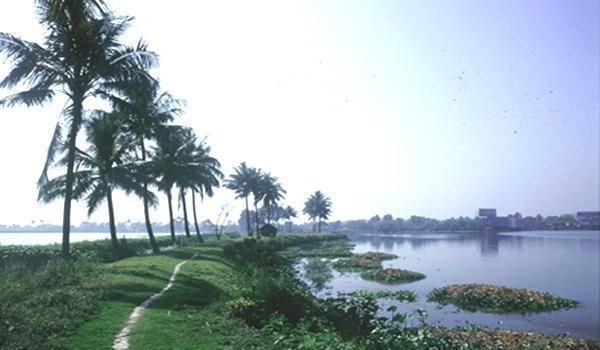 | ||
Travelogue 4 east kolkata wetlands
The East Calcutta Wetlands, also known as the East Kolkata Wetlands (22 0 27’ N 88 0 27’ E), are a complex of natural and human-made wetlands lying east of the city of Calcutta (Kolkata), West Bengal in India. The wetlands cover 125 square kilometers, and include salt marshes and salt meadows, as well as sewage farms and settling ponds. The wetlands are used to treat Kolkata's sewage, and the nutrients contained in the waste water sustain fish farms and agriculture.
Contents
- Travelogue 4 east kolkata wetlands
- Map of East Calcutta Wetlands West Bengal
- East kolkata wetlands west bengal
- Flora
- Fauna
- Sewage treatment
- Controversy
- Microbial Biodiversity
- References
Map of East Calcutta Wetlands, West Bengal
The name East Calcutta Wetlands was coined by Dr. Dhrubajyoti Ghosh, who reached this incredible but neglected part of the city searching the answer to a question: What exactly happens to the city sewage? These natural water bodies which were known just as fisheries provided the answer. Devised by local fishermen and farmers, these wetlands served, in effect, as the natural sewage treatment plant for the city. The East Kolkata Wetlands host the largest sewage fed aquaculture in the world.. After the decision to extend Salt Lake City by converting more wetlands in the area, a Public Interest Litigation (PIL) by CSO s . saved the Wetlands by a landmark judgement of Justice Umesh Chandra Banerjee of Calcutta High Court.
The East Calcutta Wetlands were designated a "wetland of international importance" under the Ramsar Convention on August 19, 2002.
East kolkata wetlands west bengal
Flora
There are about 100 plant species, which have been recorded in and around the East Calcutta Wetlands. These include sagittaria montividensis, cryptocoryene ciliata, cyperus spp., crostichum aureum, lpomoea aquatica, etc.
Several kinds of water hyacinths grow across these wetlands. Local farmers and fisher folk use water hyacinth to create a buffer between land and water to minimize erosion.
The area is also home to large numbers of coconut and betel nut trees. Many varieties of vegetables are farmed here, including cauliflower, eggplant, pumpkin, sunflower and sacred basil. Tracts of land are dedicated to paddy cultivation as well.
Fauna
Numerous species of fish are farmed in the sewage fed ponds called bheris in the East Kolkata wetlands. These include silver carp, tilapia, The area is also home to marsh mongoose and small Indian mongoose. Palm Civet and Small Indian Civet are significant in and around East Calcutta Wetlands. Approximately 20 mammals are reported from this region. Snakes found in the East Calcutta Wetland include Checkered keel back (Xenochrophis piscator), Smooth water snake (Enhydris enhydris), Buff striped keel back (Amphiesma stolata), and Bronze back tree snake (Tendrelaphis pristis) It is the Type locality of a mammalian species, called Salt Lake Marsh Mongoose.The process of urbanisation has led to disappearance of many bird species from the area.(Ghosh,A,K, 2004)
Sewage treatment
Kolkata is an example of how natural wetlands are sometimes being utilized in developing countries. Using the purification capacity of wetlands, the Indian city of Kolkata (Calcutta) has pioneered a system of sewage disposal. Built to house one million people, Kolkata is now home to over 10 million, many living in slums. But the 8,000-hectare East Kolkata Wetlands Ramsar Site, a patchwork of tree-fringed canals, vegetable plots, rice paddies and fish ponds – and the 20,000 people that work in them – daily transform one-third of the city's sewage and most of its domestic refuse into a rich harvest of fish and fresh vegetables. For example, the Mudially Fishermen's Cooperative Society is a collective of 300 families that lease 70 hectares into which wastewater from the city is released. Through a series of natural treatment processes – including the use of Eichhornia crassipes and other plants for absorbing oil, grease and heavy metals – the Cooperative has turned the area into a thriving fish farm and nature park. In 2005/06, the Cooperative sold fish worth over US$135,000 and shared income of more than US$55,000 among its members.
Controversy
Recently illegal landfills are on the rise and the wetlands are being slowly assimilated in the mainstream city. This unprecedented land development and urbanization are creating concerns about the impact on the environment. This is because the wetlands serve as a natural sponge absorbing excess rainfall and doing its bit to reduce pollution. Wetlands are under threat due to exponential expansion of real-estate projects in eastern Kolkata especially in the Salt Lake and Rajarhat sectors.
Microbial Biodiversity
Microbial Diversity is an integral part of biodiversity which includes bacteria, archaea, fungi, algae, protozoa and protists (Ghosh, A., 2007). East Kolkata Wetland shows an immense diversity of flora and fauna both at the macro and micro level. Microbial richness of a region is its unseen asset that needs to be explored and conserved. Soil samples collected from ECW shows the presence of various new strains of microbes which are not only ecologically important but also have commercial value (Ghosh, A., 2007). These include Actinobacteria which are responsible for the degradation of nitrophenol, nitroaromatic compounds, pesticides and herbicides; Proteobacteria related to the bioremediation of heavy metals, degradation and recycling of woody tissues of plants, oil contaminated soil and toxic compounds and nitrogen fixation along with the cyanobacters; other bacteria playing important roles in metal accumulation, oil degradation, antimicrobial compound production, enzyme production etc. (Ghosh, A., 2007).
